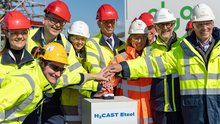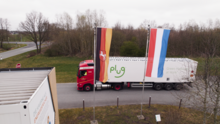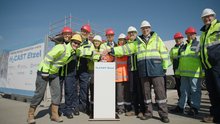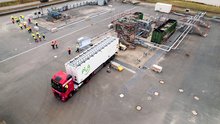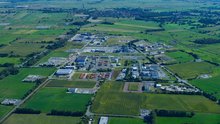Gasunie and Storag Etzel start filling hydrogen caverns and constructing the above-ground facility for the H2CAST Etzel pilot project
In Lower Saxony’s Etzel, the H2CAST pilot project, which involves converting two existing salt caverns for hydrogen storage, is now entering the next phase: Gasunie and Storag Etzel have started jointly injecting around 90 tons of hydrogen into two existing caverns. Gasunie will also start constructing the surface facility in the near future.
The project’s first phase, “H2CAST Ready”, saw the caverns filled with hydrogen to demonstrate their suitability for use as underground hydrogen storage facilities and the impermeability of the materials installed underground. The project is now continuing on schedule with the start of work on the surface facility. This is the “H2CAST Prove” phase, which will demonstrate that the facilities are operating as intended and that they guarantee the desired hydrogen quality.
On 9 May 2025, the project initiators Marc van der Linden, Gasunie Business Development Director, and Boris Richter, Managing Director of Storag Etzel, ceremonially launched the works, together with Hester Somsen, Ambassador of the Kingdom of the Netherlands to Germany, Christian Meyer, Lower Saxony’s Minister for the Environment, Energy and Climate Protection, and Olaf Lies, Lower Saxony’s Minister for Economic Affairs, Transport, Construction and Digitalisation.
The first deliveries of renewable hydrogen on behalf of Gasunie have now started and are being implemented by the service provider Plug Power from a production facility in Werlte, Germany, just 90 kilometres south of the Etzel storage facility. A total of around 90 tons of hydrogen will be injected into the two project caverns.
Marc van der Linden, Business Development Director von Gasunie:
“Hydrogen will play an important role in the future energy system, especially in making industry more sustainable. Large-scale hydrogen storage is crucial for an efficiently functioning hydrogen market. For Gasunie, these milestones are the next step in its ambition to develop hydrogen storage capacity in order to help ensure a smooth start of the hydrogen market in the Netherlands and Germany.”
In the Netherlands, Gasunie has now started developing underground hydrogen storage facilities in the northern part of the country (HyStock). In the German village of Etzel, Gasunie and Storag Etzel have been working together since 2023 on the H2CAST pilot project, which is a trial to prove the feasibility of storing hydrogen in two existing, immense caverns with a geometric volume of around 300,000 cubic metres. The aim is to develop and operate a flexible underground storage facility with a total capacity of up to 1TWh of hydrogen.
The location of the cavern storage facility in Etzel is strategically favourable with a perfect connection route to the German-Dutch hydrogen market, in close proximity to the future hydrogen core network and the Energy Hub in Wilhelmshaven.
Boris Richter, Geschäftsführer der STORAG ETZEL:
“H2CAST is a research project to test underground storage in caverns on an industrial scale. The H2CAST project will generate important information as a blueprint for the conversion of further caverns for hydrogen storage in Germany and help us gain valuable operating experience in this area. The Etzel site already operates as an energy hub with an existing connection to the European natural gas grid. Etzel is also located in the immediate vicinity of Germany’s only deep-water port in Wilhelmshaven. This port has H2-capable pipeline connections and will also play an important role in the H2 core network for hydrogen imports in the future.
We are working continuously on our hydrogen storage strategy. The Etzel caverns are flexibly scalable so that existing local underground gas and oil storage facilities can also be repurposed for hydrogen. So there are various options for expanding the project in the future. One thing is certain: underground storage of hydrogen in caverns on an industrial scale works effectively. We will be ready when the H2 market materialises.”
Christian Meyer, Minister for the Environment, Energy and Climate Protection:
“Lower Saxony is not only a leading federal state in the area of renewable energy, but also a pioneer in the production, transmission and storage of green hydrogen. H2CAST Ready shows how it can be done, and I would like to thank all our partners for this. With the pilot conversion of gas caverns to green hydrogen funded by my department, we are demonstrating how the energy transition in Germany works and how we can meet the climate targets. Storing hydrogen from surplus wind power is the blueprint for Lower Saxony and the coastal region in particular to become the leading hydrogen hub in Europe. This will also create the basis for a climate-friendly hydrogen market with renewable electricity and electrolysers on the coast, and hydrogen pipelines and storage caverns in the hinterland for Germany and the Netherlands. This development gives us security, makes us resilient and climate-neutral and also allows us to meet the high demand for hydrogen in industry, for example for green steel.”
Olaf Lies, Minister for Economic Affairs, Transport, Construction and Digitalisation:
“Renewable energies are at the heart of climate protection. As a low-lying area with an extensive coastline, Lower Saxony offers ideal conditions and unique locational advantages for the development of a comprehensive hydrogen economy and will continue to play a central role in the import, storage and distribution of energy carriers to and within Germany in the future. Without hydrogen, we will not be able to achieve the climate targets. This is why cavern storage facilities are a crucial prerequisite for achieving our climate targets on the one hand and for ensuring a secure energy supply on the other. Storag Etzel is an impressive demonstration of what is technically possible in this respect.”
